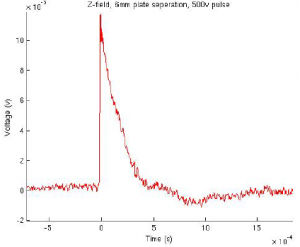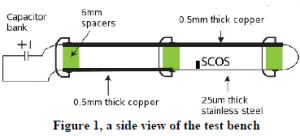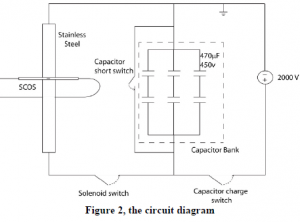Leeland Woodard and Dr. Stephen Schultz, Department of Electrical and Computer Engineering
Introduction
Improvised explosive devices (IEDs) are a leading cause of the deaths of soldiers in militarized areas. Technology is being developed to disarm IEDs by coupling electrical energy in the blasting caps of the IEDs, but in order to do so effectively, a sensor needs to be capable of measuring the voltage potential between the leads of the blasting caps without altering the electric field between them. Slab-coupled optical fiber sensors (SCOS) are electric field sensing devices that have been developed at BYU and are best suited to solving this problem, as they have the capability to measure extremely large electric fields with minimal effect on the field itself. I researched the possibility of measuring high-voltage pulses with SCOS, and found that SCOS fabricated with a polymer waveguides are capable of sensing a high-voltage pulse.
Methodology
A SCOS is fabricated by etching an optical fiber close to its core and putting a slab waveguide in the etched region. The waveguide, placed in the correct location, will couple light out of the optical fiber as a function of its refractive index. We choose waveguides that have refractive indices that change as a function of the electric field placed across them in order to measure the strength of an electric field. SCOS are traditionally fabricated with potassium titanyl phosphate (KTP) waveguides [1,2]. KTP has poor response to electric fields at low frequencies, and are therefore unsuitable for single-pulse detection. Polymer waveguides have poorer sensitivity in general, but are be frequency-independent. For this reason, all measurements in this project were taken using a SCOS with a polymer waveguide.
Figure 1 shows a longitudinal diagram of the test bench. The steel is of type 304, which has a conductivity of 1.389e6 S/m, and is 1cm in width. Figure 2 is a circuit diagram of the test bench. We used 470 mF capacitors in a configuration that gave us a total capacitance of 705 mF. The capacitors were charged up to 500 V, and then discharged through a series of wires and switches whose total resistance was measured to be 0.4 W. We calculate that, based on these values, the electric field between the steel strip and the ground plate (located 6mm above the steel strip) should be 83.3 kV/m.
Results
We were able to measure the voltage pulse relatively consistently. We measured the optical power coming out of the fiber using an electro-optic detector. Figure 3 shows a typical sample, passed through a 10th order low-pass Chebyshev filter and normalized to zero when both plates are grounded. We see a 12 mV spike in the voltage that the electro-optic detector reports at the time that the capacitors discharge. It bears mentioning that the correlation between the spike in voltage that the electro-optic detector reports does not strictly correspond with a particular strength of electric field. Because of the sensitive nature of the SCOS as a measuring device, it must be calibrated on-site with a known electric field before being used to measure the strength of unknown electric fields. Because the 12 mV spike in voltage is consistent across different tests, given similar testing conditions, we can conclude that the SCOS is accurately measuring the field, and that in this case, a 12 mV spike corresponds roughly with an 83 kV/m electric field.
The results are repeatable, but we have noticed that the polymer itself tends to heat up as it is subjected to the high-voltage pulses. As it heats up, it loses sensitivity, and after some threshold it must be allowed to cool back to room temperature before it can be used to detect another pulse.

Discussion
The ability to detect single high-voltage pulses with SCOS clearly produces the desired results. The next logical progression would be to select a waveguide that, like the polymer we used in these tests is frequency independent, but that is also more resistive to changes in temperature. Preliminary research has shown that lithium niobate would be a suitable replacement. It would be slightly less sensitive to an electric field, but theoretically would be able to withstand any number of high-voltage pulses without needing time to cool down.
Conclusion
We have demonstrated the ability to detect a high-voltage pulse using a slab-coupled optical sensor with sufficiently consistent results. The heat-dependence of the polymer waveguide is disappointing, but a SCOS fabricated with lithium niobate should fix this issue with minimal sacrifice in sensitivity.
Bibliography
- R. Gibson, R. Selfridge, S. Schultz, W. Wang, and R. Forber, “Electro-optic sensor from high Q resonance between optical D-fiber and slab waveguide,” Appl. Opt. 47, 2234-2240 (2008).
- S. Chadderdon, R. Gibson, R. Selfridge, S. Schultz, W. Wang, R. Forber, J. Luo, and A. Jen, “Electric-field sensors utilizing coupling between a D-fiber and an electro-optic polymer slab,” Appl. Opt. 50, 3505-3512 (2011).


